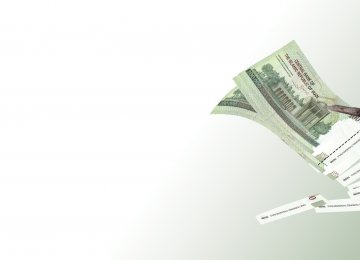Iran's currency may be redenominated to reflect the over three-decade change in day-to-day financial lingo.
The government sent a bill to parliament last week to change the currency's denomination from rial to toman, and drop one zero in the process. The move, if approved by the parliament, will ease financial transactions, though some say the bank should cut out more zeroes to make it worth the hassle.
To avoid confusion, we must delve a little into history. The rial has been Iran's official unit of value since 1973, though its inception and usage date back to 1798. Today all government and business data are in rials.
The toman, on the other hand, dates back to the Mongol conquest of Iran in the late 1200s and was in use as a super unit of currency long before the rial. It equals 10 rials.
Both units were large denominations at first, but years of inflation and economic turmoil has rendered both obsolete. To get the picture, at the onset of the Islamic Revolution in 1979, each dollar was worth 70 rials. Today, the rial has devalued so much that a dollar can buy 39,000 rials in Tehran. Quite a bit of notches in the belt there!
> Honoring Norms
Today a pack of gum costs 10,000 rials. But the real inconvenience comes with big numbers and bank transactions. Just take in the fact that this year's general government budget, bar state-owned companies, is 3,711,000,000,000,000 rials. Now you can say that's 3.7 quadrillion or 3,711 trillion rials—though for some odd reason Iranian politicians and media prefer 3,711 thousand billion rials.
This makes errors too easy and commonplace for both ordinary people and accountants, especially when they talk, it's tomans, but they must write rials. The current Cabinet proposal deals with this disparity.
The government proposal is less about shaving zeroes off banknotes and more an acknowledgment of reality, as the governor of the Central Bank of Iran admitted last week.
"From the introduction of the rial in the country's monetary and banking law, especially in the past decades, due to the cumulative effect of inflation, the rial has been dropped from daily financial transactions and substituted by toman," ILNA quoted CBI Governor Valiollah Seif as saying.
The rial, while the official unit, is rarely used in daily transactions. It has been so for over three decades. So when you go shopping the price tags are in rials, but when you ask the sales clerk for your bill, they will quote it in tomans.
"The Cabinet decided to change the country's currency from rial to toman to honor social norms and adjust to reality," IRNA quoted CBI Deputy Governor Akbar Komijani as saying.
While the CBI says the measure is focused on streamlining money circulation and accounting, the currency re-denomination is only possible because of subsiding inflationary pressures.
Seif has reigned in inflation during his tenure.
Consumer-price growth slipped below 10% this year from over 40% two years ago. The currency overhaul, for years talked about, is now possible and will signal a reboot of the economy in an age where the central bank has gained independence.
> Why Not More?
Seif said the CBI is doing separate studies for shaving more zeroes off the currency and that will be done at a later date. If we are going to lop more zeroes later, why not do all of it at once?
"The administration's decision to drop one zero is not the right thing to do. It entails all the sweat and tear of lopping more zeroes without fulfilling its goals," Tahmasb Mazaheri, a former central bank governor and economy minister, was quoted by our sister publication Donya-e-Eqtesad as saying.
To carry out the plan, all the accounting systems in Iran need adjustment, from corporations to stock markets, and also, perhaps the most costly, banknotes, said Abbas Vafadar, a member of Iranian Association of Certified Public Accountants' High Council.
Vafadar added that the project needs a revision in banknotes so people can carry more value with less notes.
Today the largest banknote is the 100,000 rial that equals $2.56. So in Iran, to carry a $100, you need 40 banknotes, making carrying large amounts of cash a real nuisance.
But the CBI has been less than transparent about what it will do to the banknote in circulation.
Seif said from March onward, the bank may start swapping banknotes. Again, why not do all of this at one go?
Regardless, the currency reorganization is a positive move, though only in terms of image or PR. As economists know, introducing a new currency format will have zero direct impact on the economy unless it is shown to be part of a more serious and sustainable effort to improve economic management and the business climate. Otherwise, it will be just a nice cosmetic makeover.







Add new comment
Read our comment policy before posting your viewpoints